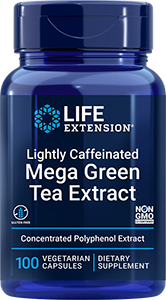- Science & Research
- Science News
- Newsletter
- 2007
- March 2

Newsletter
Newsletter
Drug tea combo reduces prostate cancer growth
 | ||||||||||||||||||||||||||||||
| ||||||||||||||||||||||||||||||
| ||||||||||||||||||||||||||||||
| Life Extension Update Exclusive Drug/tea combo reduces prostate cancer growth The March 1, 2007 issue of the journal Clinical Cancer Research published a report by researchers from the University of Wisconsin-Madison which revealed that a low dose of the COX-2 inhibitor celecoxib combined with the green tea polyphenol epigallocatechin-3-gallate (EGCG) could retard the growth of prostate cancer. Earlier research has found an association between COX-2 and several types of cancer, including prostate cancer; however, high doses of COX-2 inhibitors can have unwanted effects. University of Wisconsin professor of dermatology Hasan Mukhtar PhD and colleagues studied the effect of EGCG and NS-398, a COX-2 inhibitor similar to celecoxib, on three cultured human prostate cancer cell lines. They found that while each compound reduced cancer cell growth and limited cancer-promoting proteins, adding the compounds together increased cell growth suppression by 15 to 28 percent. The team then gave celecoxib and an oral suspension of green tea polyphenols to mice that had been implanted with human prostate cancer cells. Green tea reduced average tumor volume from 1,300 to 835 cubic millimeters, and celecoxiib reduced it to 650 cubic millimeters. When both compounds were given to the mice, tumor volume was even further reduced to 350 cubic millimeters. This group also experienced a greater reduction in the cancer marker prostate specific antigen (PSA) than animals given either compound alone. “Celecoxib and green tea have a synergistic effect -- each triggering cellular pathways that, combined, are more powerful than either agent alone,” Dr Mukhtar stated. “Our studies showed that the additive effect of green tea enables us to utilize the cancer-fighting abilities of COX-2 inhibitors, but at lower, safer doses. Prostate cancer typically arises from more than one defect in the cellular mechanics, which means that a single therapeutic might not work fighting a particular cancer long-term. If tests in human trials replicate these results, we could see a powerful combined therapy that is both simple to administer and relatively cost effective.” “We hope that a clinical trial could lead to a preventative treatment as simple as tea time.” Eicosanoids are hormones that are made within the cell membrane of each and every cell--all 60 trillion cells in the human body. Eicosanoids are 20-carbon structures. Eicosanoids have autocrine, paracrine, and endocrine effects. That is, they affect the very cell that produces the eicosanoid (autocrine effect), as well as nearby cells (paracrine effect) and distant cells (endocrine effect). As with every aspect of biology, balance is a critical issue relating to good health as well as the development and progression of various diseases. Likewise, eicosanoid balance plays a central role that puts this desired biological endpoint at the hub of the integrative medicine wheel. Eicosanoid synthesis involves the release of arachidonic acid (AA) from cell membrane phospholipids by an enzyme called phospholipase A2 (PLA2). Arachidonic acid then undergoes metabolism by cyclooxygenases (COXs) and lipoxygenases (LOXs). Arachidonic acid is an omega-6 fatty acid that is known to generate free radicals and is considered an unfavorable eicosanoid. Specific metabolites of AA, for example, PGE2 and 5-HETE, are created through the actions of the enzymes COX-2, 5-LOX, 12-LOX, and 15-LOX. These metabolites are examples of bad eicosanoids and have been implicated in prostate cancer (PC) growth and metastasis. In a study of human PC in which 5-LOX and its metabolite 5-HETE were evaluated in both malignant and benign prostate tissue within the same patient, both 5-LOX and 5-HETE were significantly over-expressed in the PC tissue. In other words, specific eicosanoids are modulators of tumor cell interactions with certain host components within the context of cancer growth, invasion, and spread. Laboratory studies have shown a significant reduction in cancer cell invasiveness by inhibitors of PLA2, as well as by general COX inhibitors such as ibuprofen (Motrin) and also by specific COX-2 inhibitors. In this particular study, the mechanism of action was related to a reduction in angiogenesis factors called matrix metalloproteinases (MMPs). Other studies have shown a significant role for COX-2 inhibition in PC with demonstration of reduction in microvessel density of the tumor related to a decrease in VEGF, a potent angiogenesis factor. Apparently, within the center of PC tumors a state of lower oxygen tension exists (hypoxic center) which stimulates VEGF. COX-2 inhibition seems to be able to prevent this hypoxia-induced up-regulation of VEGF and angiogenesis. An ibuprofen derivative called Flurbiprofen® inhibited PGE2 and reduced PC cell growth by inhibiting up-regulation of COX-2. https://www.lifeextension.com/protocols Featured Products
https://www.lifeextension.com/magazine/mag2007/mag2007_03.htm | ||||||||||||||||||||||||||||||
| If you have questions or comments concerning this issue or past issues of Life Extension Update, send them to ddye@lifeextension.com or call 1-800-678-8989. For longer life,  Dayna Dye Sign up for Life Extension Update at https://mycart.lifeextension.com/Memberships/NewsSubscription.aspx Help spread the good news about living longer and healthier. Forward this email to a friend! View previous issues of Life Extension Update in the Newsletter Archive. | ||||||||||||||||||||||||||||||
The latest news on aging, nutrition, and vitamins
Lab
Testing
How Life Extension lab testing works



